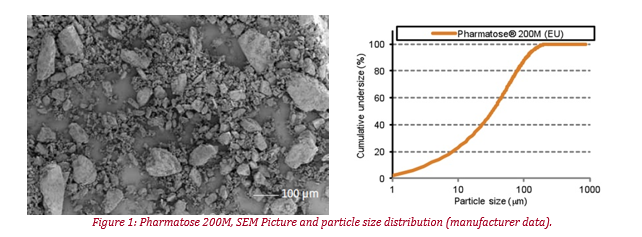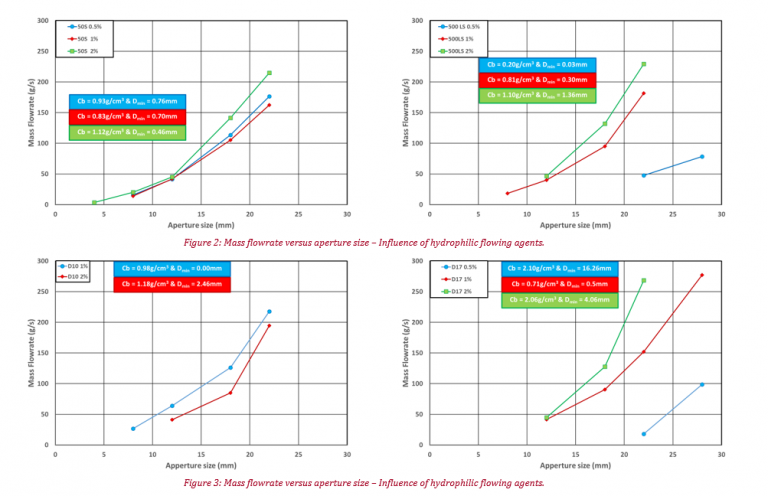Pharmaceutical
Influence of flowing agents addition on excipient flowability
The excipient used during this application note is called Pharmatose 200M and was provided by DFE Pharma. This is a pharmaceutical α-lactose monohydrate and it is mechanically milled...

Introduction
Theoretical Framework
Granular materials and fine powders are widely used in industrial applications. To control and to optimize processing methods, these materials have to be precisely characterized. The characterization methods are related either to the properties of the grains (granulometry, morphology, chemical composition, …) and to the behaviour of the bulk powder (flowability, density, blend stability, electrostatic properties, …).
However, concerning the physical behaviour of bulk powder, most of the techniques used in R&D or quality control laboratories are based on old measurement techniques. During the last decade, we have updated these techniques to meet the present requirements of R&D laboratories and production departments. In particular, the measurement processes have been automatized and rigorous initialization methods have been developed to obtain reproducible and interpretable results. Moreover, the use of image analysis techniques improves the measurements precision.
LEARN MORE ABOUT THE GRANUFLOW
A range of measurement methods has been developed to cover all the needs of industries processing powders and granular materials. However, in this application note, we will be focused on the GranuFlow instrument.
GranuFlow
GranuFlow is an improved laboratory silo compared to the ancient Hall Flow Meter (ASTM B213, ISO4490) and compared to the “Flow Through An Orifice” method described in the Pharmacopeia (USP1174).
GranuFlow is a straightforward powder flowability measurement device composed of a silo with different apertures associated with a dedicated electronic balance to measure the flowrate. This flowrate is computed automatically from the slope of the mass temporal evolution measured with the balance. The aperture size is modified quickly and easily with an original rotating system. The measurement and the result analysis are assisted by software. The flowrate is measured for a set of aperture sizes to obtain a flow curve. Finally, the whole flow curve is fitted with the well-known Beverloo theoretical model to obtain a flowability index (Cb, related to the powder flowability) and the minimum aperture size to obtain a flow (Dmin). The whole measurement is performed easily, quickly and precisely.
In this paper, we used a complete set of hole diameters: 4, 8, 12, 18, 22 and 28mm.
LEARN MORE ABOUT THE GRANUFLOW
GranuFlow Measurements
Material
The excipient used during this application note is called Pharmatose 200M and was provided by DFE Pharma. This is a pharmaceutical α-lactose monohydrate and it is mechanically milled. Because of its fine nature, milled lactose got a very poor flowability, but its relatively high surface area means that it is highly compactable. Milled lactose is therefore used primarily in wet granulation applications for tablets and capsules and for spheres made by extrusion-spheronisation.

Figure 1: Pharmatose 200M, SEM Picture and particle size distribution (manufacturer data)

Figure 2 & 3: Mass Flowrate versus aperture size - Influence of hydrophilic flowing agents
Discussion
The following table summarize all the calculated Cb and Dmin parameters for the Pharmatose 200M powders with flowing agents addition:
| Powder Name | Flowing Agent Percent (%) | Cb (g/cm3) | Dmin (mm) | Remarks |
|---|---|---|---|---|
| Pharmatose 200M + Sipernat 50S | 0.5 | 0.93 | 0.76 | |
| 1 | 0.83 | 0.70 | ||
| 2 | 1.12 | 0.46 | ||
| Pharmatose 200M + Sipernat 500LS | 0.5 | 0.20 | 0.03 | Only two points for the fit |
| 1 | 0.81 | 0.30 | ||
| 2 | 1.10 | 1.36 | ||
| Pharmatose 200M + Sipernat D10 | 0.5 | No Flow | ||
| 1 | 0.98 | 0.00 | ||
| 2 | 1.18 | 2.46 | ||
| Pharmatose 200M + Sipernat D17 | 0.5 | 2.10 | 16.26 | Only two points for the fit |
| 1 | 0.71 | 0.50 | ||
| 2 | 2.06 | 4.06 | ||
Table 1: flowability index and the standard deviation recorded for the different aged powders
For Sipernat® 500 LS, D10 and D17 addition, the more flowing agent percentage (until 2%), the better flowability (if the Beverloo regressions with two points are not taken into account). However, for Pharmatose 200M with Sipernat® 50S additive, a significative flowability improvement is achieved with an addition of 2% of flowing agent. Indeed, 0.5 and 1% additions yield to similar results.
LEARN MORE ABOUT THE GRANUFLOW
Conclusions
- The GranuFlow instrument is able to quantify powder flowability and flowing agents addition influence easily;
- The mass flowrate versus the aperture size charts can serve this purpose;
- With the Beverloo model fitting available with its software, the GranuFlow can provide information on powders flowability (with the Cb parameter) and on powders cohesion (with the Dmin parameter);
- All measurements are fast (less than five minutes for one powder, with raw data and Beverloo parameters).
References
Cascade of granular flows for characterizing segregation, G. Lumay, F. Boschin, R. Cloots, N. Vandewalle, Powder Technology 234, 32-36 (2013).
Combined effect of moisture and electrostatic charges on powder flow, A. Rescaglio, J. Schockmel, N. Vandewalle and G. Lumay, EPJ Web of Conferences 140, 13009 (2017).
Compaction dynamics of a magnetized powder, G. Lumay, S. Dorbolo and N. Vandewalle, Physical Review E 80, 041302 (2009).
Compaction of anisotropic granular materials: Experiments and simulations, G. Lumay and N. Vandewalle, Physical Review E 70, 051314 (2004).
Compaction Dynamics of Wet Granular Assemblies, J. E. Fiscina, G. Lumay, F. Ludewig and N. Vandewalle, Physical Review Letters 105, 048001 (2010).
Effect of an electric field on an intermittent granular flow, E. Mersch, G. Lumay, F. Boschini, and N. Vandewalle, Physical Review E 81, 041309 (2010).
Effect of relative air humidity on the flowability of lactose powders, G. Lumay, K. Traina, F. Boschini, V. Delaval, A. Rescaglio, R. Cloots and N. Vandewalle, Journal of Drug Delivery Science and Technology 35, 207-212 (2016).
Experimental Study of Granular Compaction Dynamics at Different Scales: Grain Mobility, Hexagonal Domains, and Packing Fraction, G. Lumay and N. Vandewalle, Physical Review Letters 95, 028002 (2005).
Flow abilities of powders and granular materials evidenced from dynamical tap density measurement, K. Traina, R. Cloots, S. Bontempi, G. Lumay, N. Vandewalle and F. Boschini, Powder Technology, 235, 842-852 (2013).
Flow of magnetized grains in a rotating drum, G. Lumay and N. Vandewalle, Physical Review E 82, 040301(R) (2010).
How tribo-electric charges modify powder flowability, A. Rescaglio, J. Schockmel, F. Francqui, N. Vandewalle, and G. Lumay, Annual Transactions of The Nordic Rheology Society 25, 17-21 (2016).
Influence of cohesives forces on the macroscopic properties of granular assemblies, G. Lumay, J. Fiscina, F. Ludewig and N. Vandewalle, AIP Conference Proceedings 1542, 995 (2013).
Linking compaction dynamics to the flow properties of powders, G. Lumay, N. Vandewalle, C. Bodson, L. Delattre and O. Gerasimov, Applied Physics Letters 89, 093505 (2006).
Linking flowability and granulometry of lactose powders, F. Boschini, V. Delaval, K. Traina, N. Vandewalle, and G. Lumay, International Journal of Pharmaceutics 494, 312–320 (2015).
Measuring the flowing properties of powders and grains, G. Lumay, F. Boschini, K. Traina, S. Bontempi, J.-C. Remy, R. Cloots, and N. Vandewall, Powder Technology 224, 19-27 (2012).
Motion of carbon nanotubes in a rotating drum: The dynamic angle of repose and a bed behavior diagram, S. L. Pirard, G. Lumay, N. Vandewalle, J-P. Pirard, Chemical Engineering Journal 146, 143-147 (2009).
Mullite coatings on ceramic substrates: Stabilisation of Al2O3–SiO2 suspensions for spray drying of composite granules suitable for reactive plasma spraying, A. Schrijnemakers, S. André, G. Lumay, N. Vandewalle, F. Boschini, R. Cloots and B. Vertruyen, Journal of the European Ceramic Society 29, 2169–2175 (2009).
Rheological behavior of β-Ti and NiTi powders produced by atomization for SLM production of open porous orthopedic implants, G. Yablokova, M. Speirs, J. Van Humbeeck, J.-P. Kruth, J. Schrooten, R. Cloots, F. Boschini, G. Lumay, J. Luyten, Powder Technology 283, 199–209 (2015).
The flow rate of granular materials through an orifice, C. Mankoc, A. Janda, R. Arévalo, J. M. Pastor, I. Zuriguel, A. Garcimartín and D. Maza, Granular Matter 9, p407–414 (2007).
The influence of grain shape, friction and cohesion on granular compaction dynamics, N. Vandewalle, G. Lumay, O. Gerasimov and F. Ludewig, The European Physical Journal E (2007).
